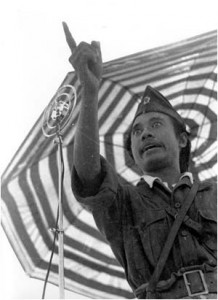Battle of Surabaya

The Battle of Surabaya was fought between pro-Independence Indonesian soldiers and militia against British and the Netherlands troops as a part of the Indonesian National Revolution. The peak of the battle was in November 1945. Despite fierce resistance, British troops managed to conquer Surabaya, the second largest city in Indonesia, on behalf of the Netherlands. The Battle was the heaviest single battle of the Revolution and became a national symbol of Indonesian resistance.[2] Considered a heroic effort by Indonesians, the battle helped galvanise Indonesian and international support for Indonesian independence. 10 November is celebrated annually as Heroes Day (Hari Pahlawan).
By the time the Allied forces arrived at the end of October 1945, the pemuda ('youth') foothold in Surabaya city was described as "a strong unified fortress".[3] Ferocious fighting erupted when 6,000 British Indian troops landed in the city to evacuate European internees. Following the killing of British Brigadier General Mallaby on 30 October,[3] the British retaliated with a punitive sweep beginning on 10 November under the cover of air attacks. Although the European forces largely captured the city in three days, the poorly armed Republicans fought for three weeks and thousands died as the population fled to the countryside.
Despite the military defeat suffered by the Republicans and a loss of manpower and weaponry that would severely hamper Republican forces for the rest of the Revolution, the battle and defence mounted by the Indonesians galvanised the nation in support of independence and helped garner international attention. For the Dutch, it removed any doubt that the Republic was not simply a gang of collaborators without popular support. It also had the effect of convincing Britain that wisdom lay on the side of neutrality in the Revolution;[2] within a few years, in fact, Britain would support the Republican cause in the United Nations.
Background
On 17 August 1945, Soekarno and Hatta declared the independence of Indonesia in Jakarta, two days after the Japanese Emperor’s surrender in the Pacific. As the news about the independence declaration spread throughout the archipelago, ordinary Indonesians felt a sense of freedom that led most to regard themselves as pro-Republican.[4] In the following weeks, power vacuums existed, both from outside and within Indonesia, creating an atmosphere of uncertainty, but also one of opportunity.[5] This euphoria of independence sometimes led to small clashes between the pemuda (youth), who had joined pro-Republic struggle groups, with the Dutch internees.[citation needed] On September 19, 1945, a group of Dutch internees supported by the Japanese raised the Dutch flag outside the Hotel Yamato (formerly Hotel Oranje) in Surabaya, East Java. This provoked Nationalist Indonesian militia, who overran the Dutch and Japanese, and tore off the blue part of the Dutch flag, changing it into Indonesian flag.[6] The leader of the Dutch group, Mr Pluegman, was killed because of mass anger.[6]
The senior Japanese commander in Surabaya, Vice Admiral Shibata Yaichoro, supported the Republicans and gave Indonesians ready access to arms.[2] On 3 October, he surrendered to a Dutch navy captain, the first Allied representative to arrive. Recognising the reality of Indonesian control of the city, he ordered his forces to hand over their remaining weapons to the Indonesians. The Indonesians were to hand them to the Allies, but neglected to do so.[2]
British forces brought in a small Dutch military contingent which it termed the Netherlands Indies Civil Administration (NICA). The British became worried about the increasing boldness and apparent strength of the nationalists, who attacked demoralized Japanese garrisons across the archipelago with rudimentary weapons such as bamboo spears in order to seize their arms. The main goals of British troops in Surabaya were the seizing of weapons from Japanese troops and Indonesian militia, taking care of former prisoner of war (POW), and sending the remaining Japanese troops back to Japan. The Japanese troops surrendered their weapons, but more than 20,000 Indonesian troops and several thousand militia refused to hand over their weapons.[citation needed]
In September and October 1945 a series of incidents took place involving pro-Dutch Eurasians, and atrocities were committed by Indonesian mobs against European internees.[8] In late October and early November, the leadership of the mass Muslim organisations Nahdlatul Ulama and Masyumi, declared that war in defence of the Indonesian fatherland was Holy War, and thus an obligation for all Muslims. Kyai and their students, began to stream into Surabaya from Islamic boarding schools throughout East Java. The charismatic Bung Tomo made use of local radio to encourage an atmosphere of fanatical revolutionary fervour across the city.[2] 6,000 British Indian troops were sent into the explosive city on 25 October to evacuate European internees and within three days fighting began.[2] The Indian forces were on the verge of being wiped out by 10,000–20,000 Indonesian armed regulars of the newly formed People's Security Army (TKI) and mobs of 70,000–140,000 people, however, the British flew in the influential President Sukarno, and his ministers Hatta and Amir Sjarifuddin, and a ceasefire was achieved on 30 October.[2]
On October 26, 1945, Brigadier A. W. S Mallaby reached an agreement with Mr Suryo, the Republic of Indonesia's governor of East Java that the British would not ask Indonesian troops/militia to hand over their weapons. An apparent misunderstanding about the agreement between British troops in Jakarta (led by Lieutenant General Sir Philip Christison) and Mallaby's troops in Surabaya was to have have serious ramifications.
Combatants
Initially British troops were 6,000-strong light-armed Indian soldiers from 49th Infantry Brigade of the 23rd Division. When the battle reached its peak, British sent additional troops which consisted of 24,000 fully-armed soldiers from the 5th Division, 24 Sherman tanks, 24 armed aircraft, 2 cruisers and 3 destroyers.[1]
Indonesian forces consisted of 20,000 soldiers from the newly-formed Tentara Keamanan Rakyat (TKR; People's Security Troops) and estimated 100,000-120,000 irregulars. TKR was formed by the former members of Peta, a semi-military organization during Japanese occupation. The irregulars consisted of pro-Independence mob, armed with rifles, swords, and spears. Some of their weapons were taken from the demoralized Japanese troops. [9]
The battle
Beginning
On October 27, 1945, a British plane from Jakarta dropped leaflets over Surabaya urging all Indonesian troops and militia to surrender their weapons. The leader of Indonesian troops and militia was angered, seeing it as a breaking of the agreement reached with Mallaby earlier. On October 28, 1945, they attacked British troops in Surabaya killing more than 200 ill-prepared British troops. On 30 October, in desperation the British flew Sukarno (president of RI), Mohammad Hatta (the vice president of RI), and Amir Syarifuddin Harahap (the minister of information of Indonesia) into the Surabaya. The three were seen as the only Indonesian leaders likely able to quell fighting between Republican and British Indian forces in which the British Brigade were hopelessly outnumbered and facing annihilation. A cease fire was negotiated with Maj. Gen. Hawthorn (the commander of British 23rd division) and Brig. Mallaby and immediately adhered to. Fighting, however, soon recommenced after confused communications and mistrust between the two sides, leading to the famed Battle of Surabaya.[10]
Death of Brigadier Mallaby
Brigadier Mallaby was killed in Surabaya on 30 October 1945 under unclear circumstances that remain debated today. His death was a significant turning point and catalyst for the battle to come. Brigadier Mallaby spread the news about the new agreement to his troops around Surabaya. When his car approached the British troops post on Internatio building near the Jembatan Merah ("Red Bridge"), his car was surrounded by Indonesian Republican militia. Fearing that their commander was about to be attacked by the militia, the British troops in the Internatio building, led by Major Venu K. Gopal, fired into the air to disperse the Indonesian militia.[9] The militia, thinking that British were taking hostile action, fired back at the British troops.[9]
Captain R.C. Smith who was in the stationary car reports that a young republican shot and killed Mallaby after a short conversation. Smith then reports throwing a grenade from the car in the direction of where he thought the shooter was hiding. Although he is not sure whether it hit its target, the explosion caused the back seat of the car to ignite.[9] Other accounts, according to the same source,[9] stated that it was the explosion and not a shooter that killed Mallaby. Regardless of the exact details of his death, it was followed by a British order for Indonesian surrender and then on 10 November by a large British retaliatory attack.[2]
The major battle
Indonesian M1 Garand rifle (below) captured by the British SAS. Photo taken in the London Imperial War Museum
Lt. Gen. Sir Philip Christison was angered when he heard that Brig. Mallaby was killed in Surabaya. During a lull in fighting, the British brought in reinforcements and evacuated the internees.[2] An additional 24,000 fully armed Indian 5th Division troops led by Major General E. C. Mansergh, with 21 M4 Sherman tanks, 2 cruisers and 3 destroyers were sent in[1]
On November 9, 1945, British issued an ultimatum for Indonesian troops and militia to surrender all weapons, or Surabaya would be attacked from land, sea, and air.[citation needed] Republicans refused the ultimatum. At dawn on 10 November, a day now commemorated in Indonesia as Heroes' Day, British troops began a bloody punitive sweep through the city under the cover of naval and air bombardment. Despite the fanatical resistance of Indonesians, half the city was conquered in three days and the fighting over in three weeks. At least 6,000 Indonesians died and thousands more fled the devastated city.[2]
Consequences of the battle
The Heroes Monument in Surabaya commemorating the fierce battle.
The Republicans lost much of their manpower, but it was the loss of weaponry that would severely hamper Republican military efforts for the remainder of the independence struggle.[2] The battle for Surabaya was the bloodiest single engagement of the war, and demonstrated the determination of the rag-tag nationalist forces; their sacrificial resistance became a symbol and rallying-cry for the Revolution. It also made the British reluctant to be sucked into a war it did not need, considering how outstretched their resources in southeast Asia were during the period after the Japanese surrender; within a few years, in fact, Britain openly supported the Republican cause in the United Nations. It was also a watershed for the Dutch as it removed any doubt that the Republic was not simply a gang of collaborators without popular support.[2] In November 1946, the last British troops left Indonesia. The "Heroes of the 10th of November" statue in Surabaya commemorates this battle. 10 November is now commemorated in Indonesia as "Heroes' Day", in memory of the battle.
Notes
^ a b c d e f The Battle for Surabaya, Indonesian Heritage.
^ a b c d e f g h i j k l Ricklefs (1991), page 217
^ a b J. G. A. Parrott (October 1975). "Who Killed Brigadier Mallaby?". Indonesia 20: 87–111. doi:10.2307/3350997. Retrieved on 2006-11-27.
^ Ricklefs (1991), pages 214-215
^ Friend, Theodore (2003). Indonesian Destinies. The Belknap Press of Harvard University Press, p.32. ISBN 0-674-01834-6.
^ a b Orange / Yamato / Mandarin Majapahit Hotel, Petra Christian University Surabaya
^ Frederick, William H. (April 1982). "In Memoriam: Sutomo". Indonesia 33: 127–128. Cornell University outheast Asia Program. seap.indo/1107016901.
^ Frederick, Willam H. (1989). Visions and Heat: The Making of the Indonesian Revolution. Athens, Ohio: Ohio University Press, pp.237-243. ISBN 0-8214-0906-9.
^ a b c d e J. G. A. Parrott (October 1975). "Who Killed Brigadier Mallaby?" (pdf). 87–111 Retrieved on 2006-11-27.
^ Reid, Anthony (1973). The Indonesian National Revolution 1945-1950. Melbourne: Longman Pty Ltd, p.52. ISBN 0-582-71046-4.

